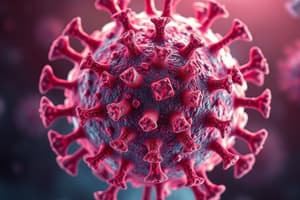Podcast
Questions and Answers
What characterizes reverse zoonoses?
What characterizes reverse zoonoses?
- Spread of a virus solely through environmental sources.
- Infection of an animal by a virus that originated in a human. (correct)
- Infection of a human by a virus originating in an animal.
- Transmission of a virus from animal to human.
Which statement best describes the size of virions?
Which statement best describes the size of virions?
- Virions vary greatly in size but are never larger than $10nm$.
- Virions are generally larger than prokaryotic cells.
- Virions can only be observed under a regular light microscope.
- Virions typically range from $20nm$ to $900nm$, smaller than most cells. (correct)
What role did Wendell Stanley play in the field of virology?
What role did Wendell Stanley play in the field of virology?
- He discovered how to transmit viruses through water.
- He was the first to crystallize the structure of a virus. (correct)
- He was the first person to isolate DNA viruses.
- He invented the first vaccine for bacterial infections.
Why are bacteriophages not a concern in human food?
Why are bacteriophages not a concern in human food?
What was the contribution of Stanley's work to the development of vaccines?
What was the contribution of Stanley's work to the development of vaccines?
What is the term used to describe the variety of organisms that a virus can infect?
What is the term used to describe the variety of organisms that a virus can infect?
Which statement best describes how viruses reproduce?
Which statement best describes how viruses reproduce?
What mechanism involves an arthropod carrying a virus on the outside of its body?
What mechanism involves an arthropod carrying a virus on the outside of its body?
Which type of virus specifically infects bacterial cells?
Which type of virus specifically infects bacterial cells?
What characterizes viruses that are classified as zoonotic?
What characterizes viruses that are classified as zoonotic?
Which of the following is NOT a characteristic of viruses?
Which of the following is NOT a characteristic of viruses?
What is a major challenge in treating infections caused by viruses?
What is a major challenge in treating infections caused by viruses?
Which component surrounds the viral genome and aids in infectivity?
Which component surrounds the viral genome and aids in infectivity?
What is the primary role of bacteriophages in the viral life cycle?
What is the primary role of bacteriophages in the viral life cycle?
Which mechanism is primarily responsible for the transmission of the Ebola virus?
Which mechanism is primarily responsible for the transmission of the Ebola virus?
Which of the following correctly describes host range specificity in viruses?
Which of the following correctly describes host range specificity in viruses?
What differentiates viroids from viruses?
What differentiates viroids from viruses?
What is a common consequence of viral infection on a host cell?
What is a common consequence of viral infection on a host cell?
Which historical practice was used to prevent smallpox before modern vaccines were developed?
Which historical practice was used to prevent smallpox before modern vaccines were developed?
In the context of viral infections, what defines a 'viral epidemic'?
In the context of viral infections, what defines a 'viral epidemic'?
What method is crucial for isolating viruses in the laboratory?
What method is crucial for isolating viruses in the laboratory?
Flashcards
Reverse zoonosis
Reverse zoonosis
An animal infection caused by a virus originating from humans.
Bacteriophages in food
Bacteriophages in food
Humans need not worry about bacteriophages in their food, as they do not infect humans.
Viral transmission methods
Viral transmission methods
Three ways viruses can spread are through direct contact, airborne particles, and indirect contact (e.g., contaminated surfaces).
Virion size
Virion size
Signup and view all the flashcards
Wendell Stanley
Wendell Stanley
Signup and view all the flashcards
Viral Pathogens
Viral Pathogens
Signup and view all the flashcards
Host Range
Host Range
Signup and view all the flashcards
Bacteriophage
Bacteriophage
Signup and view all the flashcards
Viral Transmission
Viral Transmission
Signup and view all the flashcards
Vector Transmission
Vector Transmission
Signup and view all the flashcards
Mechanical Vector
Mechanical Vector
Signup and view all the flashcards
Biological Vector
Biological Vector
Signup and view all the flashcards
Zoonoses
Zoonoses
Signup and view all the flashcards
Viral Infections (historical)
Viral Infections (historical)
Signup and view all the flashcards
Variolation/inoculation (smallpox)
Variolation/inoculation (smallpox)
Signup and view all the flashcards
Vaccination (Edward Jenner)
Vaccination (Edward Jenner)
Signup and view all the flashcards
Electron Microscope
Electron Microscope
Signup and view all the flashcards
Tobacco Mosaic Virus (TMV)
Tobacco Mosaic Virus (TMV)
Signup and view all the flashcards
2014 Ebola Outbreak Statistics
2014 Ebola Outbreak Statistics
Signup and view all the flashcards
Study Notes
Acellular Pathogens: Viruses
- Viruses are tiny, filterable agents smaller than bacteria, discovered in 1892.
- Dmitri Ivanovski identified tobacco mosaic disease (TMD) as caused by a filterable agent, not a bacterium.
- Unlike cellular organisms, viruses are acellular, meaning they're not composed of cells.
- To reproduce, viruses must infect a host cell.
- Viruses' genomes enter host cells and direct the creation of new viral components (proteins and nucleic acids).
- New virions are assembled within the host cell and release the viral genome into another host cell for continued infection.
- Viruses are obligate intracellular parasites.
- Viruses have a protein capsid surrounding their genome (DNA or RNA, never both).
- Some viruses also have a phospholipid membrane with viral glycoproteins.
- Viruses lack genes for many vital functions, relying on host cells for reproduction.
- Viruses' evolutionary origins are unclear and not included in the tree of life.
Viral Epidemics and History
- Public health measures have dramatically decreased viral mortality, but epidemics can spread globally.
- The 2009 H1N1 influenza outbreak and the 2014 Ebola outbreak are examples of this global spread.
- Inoculation (variolation) methods were used to prevent smallpox as early as the 17th century.
- Edward Jenner developed vaccination using cowpox to prevent smallpox in the late 18th century.
- Electron microscopes allowed visualization of viruses, aiding understanding of structure in the late 1930s.
Viral Hosts and Transmission
- Viruses can infect various organisms (plants, animals, bacteria, archaea).
- Host range varies, with some infecting specific hosts and cells.
- Bacteriophages infect bacteria.
- Viral effects range from cell death to altered cell growth to no visible effect.
- Transmission occurs through direct / indirect contact (fomites) or vectors (e.g., arthropods).
- Viruses can move between animal and human hosts (zoonoses), and in reverse.
Viral Structure and Discovery
- Virions are too small to be seen with light microscopes, ranging from 20 to 900 nm.
- Giant viruses (e.g., Pandoravirus salinus, Pithovirus sibericum) are larger, approaching bacterial cell sizes.
- Wendell Stanley crystallized the tobacco mosaic virus in 1935, revealing protein and RNA composition.
- Subsequent research furthered understanding of viral structure.
Studying That Suits You
Use AI to generate personalized quizzes and flashcards to suit your learning preferences.




